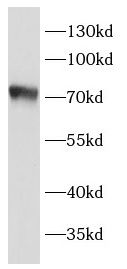Products
TGFBR2 antibody
Category:
Research Area:
| Synonyms: | AAT3 antibody, FAA3 antibody, LDS1B antibody, LDS2B antibody, MFS2 antibody, RIIC antibody, TAAD2 antibody, TbetaR II antibody, TGF beta receptor type 2 antibody, TGF beta receptor type II antibody, TGF beta type II receptor antibody, TGFbeta RII antibody, TGFBR2 antibody, TGFR 2 antibody | ||
| Catalogue No.: | FNab08644 | Reactivity: | Human, Mouse, Rat |
| Host: | Rabbit | Tested Application: | ELISA, WB, IHC |
| Clonality: | polyclonal | Isotype: | IgG |
- SPECIFICATIONS
- Product Name
- TGFBR2 antibody
- Catalogue No.
- FNab08644
- Size
- 100μg
- Form
- liquid
- Purification
- Immunogen affinity purified
- Purity
- ≥95% as determined by SDS-PAGE
- Clonality
- polyclonal
- Isotype
- IgG
- Storage
- PBS with 0.02% sodium azide and 50% glycerol pH 7.3, -20℃ for 12 months(Avoid repeated freeze / thaw cycles.)
Immunogen
- Immunogen
- transforming growth factor, beta receptor II(70/80kDa)
- Alternative Names
- AAT3 antibody, FAA3 antibody, LDS1B antibody, LDS2B antibody, MFS2 antibody, RIIC antibody, TAAD2 antibody, TbetaR II antibody, TGF beta receptor type 2 antibody, TGF beta receptor type II antibody, TGF beta type II receptor antibody, TGFbeta RII antibody, TGFBR2 antibody, TGFR 2 antibody
- UniProt ID
- P37173
- Observed MW
- 70 kDa
Application
- Tested Applications
- ELISA, WB, IHC
- Recommended dilution
- WB: 1:200-1:2000; IHC: 1:20-1:200
Validated Images
 HepG2 cells were subjected to SDS PAGE followed by western blot with FNab08644(TGFBR2 antibody) at dilution of 1:1000
HepG2 cells were subjected to SDS PAGE followed by western blot with FNab08644(TGFBR2 antibody) at dilution of 1:1000
 Immunohistochemistry of paraffin-embedded human breast cancer tissue slide using FNab08644(TGFBR2 Antibody) at dilution of 1:50
Immunohistochemistry of paraffin-embedded human breast cancer tissue slide using FNab08644(TGFBR2 Antibody) at dilution of 1:50
- Background
- Transmembrane serine/threonine kinase forming with the TGF-beta type I serine/threonine kinase receptor, TGFBR1, the non-promiscuous receptor for the TGF-beta cytokines TGFB1, TGFB2 and TGFB3. Transduces the TGFB1, TGFB2 and TGFB3 signal from the cell surface to the cytoplasm and is thus regulating a plethora of physiological and pathological processes including cell cycle arrest in epithelial and hematopoietic cells, control of mesenchymal cell proliferation and differentiation, wound healing, extracellular matrix production, immunosuppression and carcinogenesis. The formation of the receptor complex composed of 2 TGFBR1 and 2 TGFBR2 molecules symmetrically bound to the cytokine dimer results in the phosphorylation and the activation of TGFRB1 by the constitutively active TGFBR2. Activated TGFBR1 phosphorylates SMAD2 which dissociates from the receptor and interacts with SMAD4. The SMAD2-SMAD4 complex is subsequently translocated to the nucleus where it modulates the transcription of the TGF-beta-regulated genes. This constitutes the canonical SMAD-dependent TGF-beta signaling cascade. Also involved in non-canonical, SMAD-independent TGF-beta signaling pathways.



